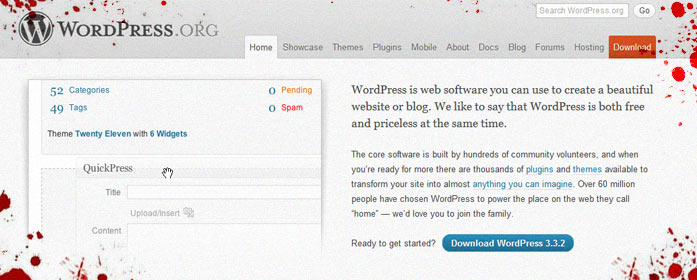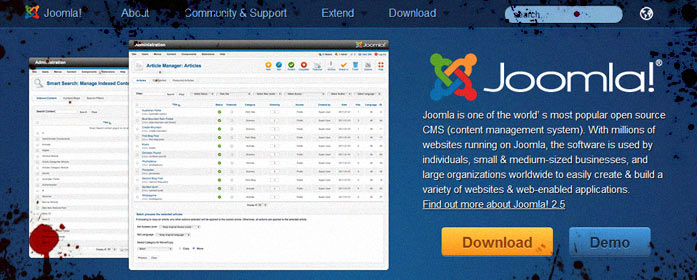 The WordPress v Joomla debate has been an argument — no, an all-out war — for years now. The issue with this war of the CMS titans is that it’s largely being fought by biased individuals, rather than debated from an objective standpoint.
I’m not the first person to discuss this topic and I certainly won’t be the last. I feel, however, that there has been no really good comparison between Joomla and WordPress in recent times. For this reason, SitePoint is going to bring you a series of articles discussing every major area of comparison between WordPress and Joomla as they stand in 2012. This is what you can expect to see throughout the six blogposts:
The WordPress v Joomla debate has been an argument — no, an all-out war — for years now. The issue with this war of the CMS titans is that it’s largely being fought by biased individuals, rather than debated from an objective standpoint.
I’m not the first person to discuss this topic and I certainly won’t be the last. I feel, however, that there has been no really good comparison between Joomla and WordPress in recent times. For this reason, SitePoint is going to bring you a series of articles discussing every major area of comparison between WordPress and Joomla as they stand in 2012. This is what you can expect to see throughout the six blogposts:
- An Introduction to WordPress and Joomla
- Joomla Templates v WordPress Themes/Templates
- Customization Potential of WordPress and Joomla — plugins, extensions, etc
- WordPress SEO v Joomla SEO
- Is Joomla or WordPress Better in the Support Department?
- The Winner Announced!
An Introduction to WordPress
WordPress really needs no introduction as it is currently the most widely used CMS in the world. I would, however, like to draw your attention to the following information:Technical Stuff
The WordPress CMS is based on PHP and, like most content management systems, uses MySQL for database management. For these reasons you’re going to want to make sure you’re using an Apache (Linux) host with mod_rewrite enabled (for URL rewriting) because it will make your life a whole lot easier. WordPress is licensed under the GNU GPL which outlines how the CMS may be used by the public.Standalone v Hosted
An interesting point to note is that WordPress offers both a standalone CMS as well as a hosted WordPress facility at wordpress.com — so even if you don’t have your own domain, that doesn’t mean you cannot run your own website. It’s worth noting that if you use wordpress.com to host a website your website address will be something like yoursitename.wordpress.com. For this reason I would always recommend investing in a cheap hosting account and registering your own domain so you can use the standalone version of the WordPress CMS, which is obtainable from wordpress.org. The wordpress.com version of WordPress is also quite a bit more limited than the self-hosted version.From Then to Now
Wordpress was created in 2003 as a successor to what was known as b2/cafelog — which apparently had a user base of around 2000 at that stage. The system was created by Matt Mullenweg and Mike Little along with contributions by the developer of b2/cafelog, Michel Valdrighi. Since its inception, WordPress has grown to be the most popular CMS on the internet, currently hosting approximately 25% of the web’s top sites and around 15% of Alexa Internet’s “Top 1 Million” websites. [Source]. It is currently sitting at version 3.4, and the roadmap suggests that versions 3.5 through to 3.6 should be released in 2012.
WordPress has thousands of well-known brands as active testimonials for their CMS. Some of the more popular websites currently using WordPress are:
And of course, SitePoint itself is created using WordPress!
Since its inception, WordPress has grown to be the most popular CMS on the internet, currently hosting approximately 25% of the web’s top sites and around 15% of Alexa Internet’s “Top 1 Million” websites. [Source]. It is currently sitting at version 3.4, and the roadmap suggests that versions 3.5 through to 3.6 should be released in 2012.
WordPress has thousands of well-known brands as active testimonials for their CMS. Some of the more popular websites currently using WordPress are:
And of course, SitePoint itself is created using WordPress!
Content Structure of the WordPress CMS
WordPress’ content structure is basically broken down into Pages and Posts. Pages are generally used for static content (eg an About Us page), whereas Posts are your regular updates (eg blog posts). Each page/post can be assigned to a menu which will form the base of your website. Posts are grouped into Categories, and defined even further by the use of Tags. Additional content can then be added in and around the base content using Widgets. Widgets can be placed in several places on your pages, and you can define pages on which you would not like to display each widget. There are many widgets that are natively available, including tag clouds, recent posts widgets, post categories and a whole bunch of others. Functionality can be added to WordPress by downloading and installing Plugins. There are thousands of Plugins available which will perform practically every function you could ever think of. You can use Plugins to turn your site into an e-commerce store, a download repository, a sports statistics website and many other weird and wonderful applications. Now let’s take a look at the Joomla CMS.An Introduction to Joomla
Although Joomla could easily be considered the second most popular CMS around (sorry Drupal fans), it would probably be fair to say that it is still relatively unknown to many who aren’t familiar with web design/blogging or aren’t even sure what a CMS is.
Technical Details
Joomla, like WordPress, is based on PHP and MySQL, which means you should also be looking to use an Apache host here. I feel Joomla’s file structure is far more confusing and cluttered than the WordPress file/content structure is. We spent significantly more time deciphering Joomla’s object-oriented code than we needed to spend for WordPress. For the average user, however, this is not much of a concern. Joomla, unlike WordPress, does not have a hosted facility. This means you will need to host your own Joomla website and have your own domain name in order to use the CMS.From Then to Now
Joomla was created in 2005, partly as a successor to Mambo. The J! development team created the Joomla project in response to a controversial move by the founders of Mambo, who turned the project into a non-profit organisation. The development team also founded a movement — OpenSourceMatters.org — and within hours had hundreds of fans voicing their support. Joomla was created with the intention of creating a free and open-source CMS, as well as a great online community centered around the CMS. Joomla have just released version 2.5 and seem to be making a conscious effort to release updates with new functionality on a regular basis. This is good: we are finally starting to see some functionality incorporated into Joomla that should have been there from the beginning. On the downside, frequent updates often mean we need to wait for Extension developers to update their components before we can successfully update to the latest version of Joomla. While Joomla doesn’t enjoy the same fanfare WordPress does, there are still some big names using Joomla as their CMS of choice. Linux.com is one of the biggest names using Joomla for its website and has been using it successfully for a number of years. Interestingly, McDonalds in the Arabian Peninsula has also opted for Joomla to back their website. Another big name using Joomla is eBay – not for ebay.com, though. eBay uses Joomla to manage their intranet of 16,000-plus employees. This application in particular highlights how powerful Joomla can be.The Joomla Content Structure
At first, Joomla seems slightly more complicated than WordPress. My opinion is that this is simply because of its naming of different content items and some slightly less obvious ways of achieving certain objectives. For this reason, most people who start out with Joomla find figuring out the content structure to be a bit of a learning curve and this often leads to them abandoning Joomla altogether. What most of these people don’t understand, initially, is that Joomla’s content structure is very similar to WordPress’. Articles or Components generate a page’s main content. Content is linked to a menu using menu items — which basically provide a vehicle for the display of a certain piece of content. Menu items can be a whole host of different things — for instance, a menu item can be set to display a single article, an entire category of items, the output from an extension/component which has been installed (eg a contact form component) or even an external URL. This is slightly different to the WordPress functionality, in which functionality is usually added to a Page by embedding a little piece of code (Shortcode) which is provided by the associated plugin. Modules are Joomla’s equivalent of Widgets. Modules are displayed around the main content and are generally used to add in peripheral bits of content; for instance a Weather module, a Login module or a Latest News module. Joomla’s menus also need to be created using modules, or else they will not show up anywhere! This is exactly how WordPress’ menus function too. A Menu widget needs to be created which will be set to display a particular menu in a specific position. Joomla can be extended by using Components, Modules and Plugins, all of which can be downloaded from the Joomla Extensions Directory. Whereas WordPress uses the term “Plugin” to encompass all of its extensions, Joomla tries to narrow it down a bit by grouping extensions by the function that the extension performs. Unfortunately, I think this is one of the areas which leaves first-time users a bit bewildered.Conclusion
Right off the bat it is quite evident that WordPress is the more popular of the two systems. That said, WordPress is also a couple years older than Joomla. WordPress was created to enable creators of content to easily publish that content. It is currently used as the blogging platform of choice. My opinion is that it is great at exactly that — blogging/content curation — but perhaps not as flexible in other departments. Joomla is generally used for websites of a slightly more static nature, as well as for more advanced uses, such as the eBay intranet. This doesn’t mean that it cannot power blogs or content-oriented websites, but I tend to find that it’s not everybody’s first choice for this. WordPress’ content structure is slightly easier to grasp for newbies and first-time users of Joomla tend to have trouble grasping the terminology and application of certain functions. In the next post we’ll discuss templating for Joomla and WordPress. In the meantime, which CMS do you prefer? Let me know in the comments!Frequently Asked Questions about WordPress vs Joomla
What are the key differences between WordPress and Joomla in terms of content management?
WordPress and Joomla are both popular content management systems (CMS), but they differ in several ways. WordPress is known for its user-friendly interface and a vast array of themes and plugins. It’s ideal for beginners and those who want to create a blog or small website. Joomla, on the other hand, offers more advanced user management and can handle larger content volumes. It’s suitable for social networking sites and e-commerce. However, it has a steeper learning curve compared to WordPress.
How does SEO compare between WordPress and Joomla?
Both WordPress and Joomla are SEO-friendly, but they approach SEO differently. WordPress has a slight edge due to the availability of SEO plugins like Yoast SEO, which makes optimizing your site easier. Joomla also has SEO extensions, but they are not as comprehensive as those offered by WordPress.
Is Joomla a good alternative to WordPress?
Joomla is a robust CMS and can be a good alternative to WordPress, depending on your needs. If you require advanced user permissions or want to manage a lot of articles, Joomla might be a better choice. However, if you’re looking for simplicity and ease of use, WordPress might be more suitable.
What are some of the best Joomla extensions for SEO?
Some of the best Joomla extensions for SEO include EFSEO – Easy Frontend SEO, JSitemap, and SH404SEF. These extensions offer features like metadata management, URL rewriting, and sitemap generation, which can help improve your site’s SEO.
How does the community support compare between WordPress and Joomla?
Both WordPress and Joomla have large, active communities. WordPress, being more popular, has a larger community and more readily available resources. Joomla’s community is smaller but is known for its dedication and expertise.
How do WordPress and Joomla handle security?
Both WordPress and Joomla take security seriously. WordPress has an automatic update feature for minor releases and security updates. Joomla also offers its own set of security extensions. However, the security of your site will also depend on factors like hosting, using updated themes and plugins, and following best security practices.
Can I switch from WordPress to Joomla or vice versa?
Yes, it’s possible to switch from WordPress to Joomla or vice versa. However, the process can be complex and requires careful planning. You’ll need to migrate your content, recreate your design, and set up your SEO settings among other things.
Which CMS is better for e-commerce, WordPress or Joomla?
Both WordPress and Joomla can handle e-commerce sites. WordPress users often use the WooCommerce plugin, while Joomla users can use extensions like VirtueMart or HikaShop. The choice between the two often comes down to personal preference and specific needs.
How customizable are WordPress and Joomla?
Both WordPress and Joomla offer high levels of customization. WordPress offers thousands of themes and plugins, allowing you to change your site’s appearance and functionality. Joomla also offers many templates and extensions, and it has a more flexible structure for content and layout.
Which CMS is more cost-effective, WordPress or Joomla?
Both WordPress and Joomla are free to download and use. The cost can come in when you consider factors like hosting, premium themes or templates, extensions or plugins, and potential development costs. The total cost can vary depending on your specific needs and choices.
Mark runs a design studio in Durban, South Africa. He is a web designer and branding expert for small businesses and entrepreneurs. Connect with Mark on Google+.

